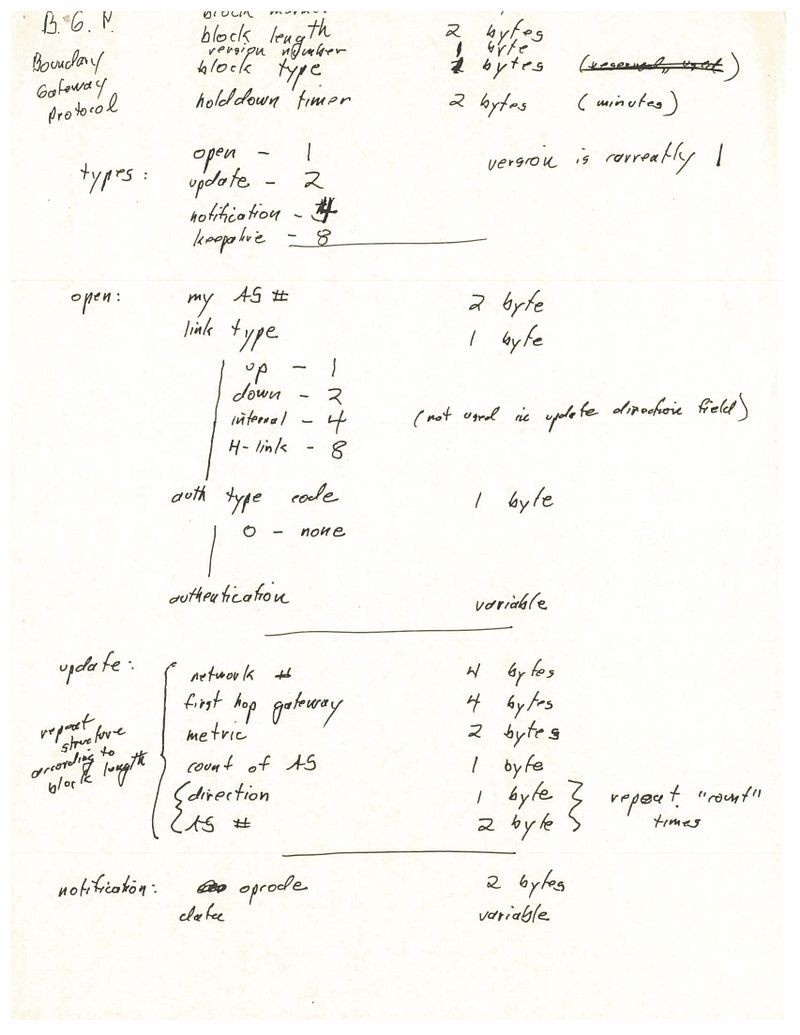
The Computer History Museum has undertaken a new and groundbreaking collaboration with San Jose-based Cisco Systems, Inc. to preserve the company’s three-decade history. The newly established Cisco Archive will document, preserve, and reveal Cisco’s significant role in shaping the Internet and becoming the worldwide leader in networking. One of the most amazing artifacts collected so far tells a classic Silicon Valley story.
It was 1989. Kirk Lougheed of Cisco and Yakov Rekhter of IBM were having lunch in a meeting hall cafeteria at an Internet Engineering Task Force (IETF) conference.
They wrote a new routing protocol that became RFC (Request for Comment) 1105, the Border Gateway Protocol (BGP), known to many as the “Two Napkin Protocol” — in reference to the napkins they used to capture their thoughts.

BGP notes written on napkin
BGP is still integral to an Internet that has grown from 80 thousand hosts in 1989 to over one billion hosts today. BGP and the World Wide Web share a 25th birthday thanks to Tim Berners-Lee writing the original Web proposal in 1989.
BGP is the routing protocol of the global Internet, as well as of service provider private networks. BGP has expanded upon its original purpose of carrying Internet reachability information. It can now carry routes for Multicast, IPv6, VPNs, and a variety of other data. In other words, BGP continues to play a critical role in allowing the Internet to move large amounts of data quickly and efficiently.

BGP Notes written on Napkin
One of the most unique contributions to the Cisco Archive are photocopies of the BGP notes written on the napkins. The napkins themselves have been lost to the landfill.
Complementing the napkins are other items in the Cisco Archive collection, such as the winter 1989 edition of The Packet: Cisco Systems Customer Services Newsletter. It features a cover story on BGP. It’s a throwback to Cisco’s earliest years, highlighting the company’s rapid expansion in concert with the Internet, its emphasis on customer needs, and how it took an active role in creating open standards and policies.

The Packet: Systems User Customer Services Newsletter, front page
A few hours brainstorming in one afternoon produced a protocol that has lasted for 25 years. Quite the achievement. How many lunches are that productive?
Preserving these stories is integral to preserving the history of both computing and of our region. However, it is not easy to promote history in fast-moving Silicon Valley – always fixated on the next innovation, rarely looking back. The Museum hopes to encourage other Silicon Valley companies to make serious efforts to preserve their unique history, not just for historians but because knowing the past can inspire their own future efforts. By investing in its past a company leverages its tradition of innovation, entrepreneurship, customer service, and responsible administration. Wells Fargo’s Stagecoach brand is a clear example of how history can be woven into the fabric of a company. The Two-Napkin Protocol blog was first posted internally within Cisco, and employee comments showcased the inspiring role history can have. My favorites are “Spellbinding… Amazing… Mind Blowing… Lovable fact of 3 brains working for the good of many!” and “This is a reminder of some of the anecdotal moments in history that made Cisco Great. Bring it back with a 2015 relevance!”
In the past, business history played a limited role in traditional historical research, but with the rise of technology and its impact on the world economy in the 21st century, business is more than ever at the intersection of everyone’s lives. We can no longer understand the world we live in without documenting how the internet explosion and international commerce have changed the globe. The methods and institutions that preserved your grandparent’s history do not suffice in today’s world. Join the Museum in helping preserve our history.